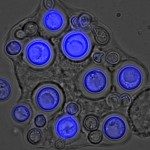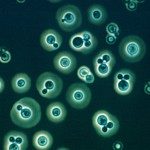Link to Pubmed [PMID] – 11283063
J. Clin. Microbiol. 2001 Apr;39(4):1402-6
The aim of this study was to standardize a method to determine whether two strains of Cryptococcus neoformans could be considered epidemiologically linked. We hypothesized that strains isolated from the same patient were epidemiologically linked and that those isolated from different patients were unrelated. We used 17 environmental isolates and 97 clinical isolates from 31 patients diagnosed with cryptococcosis (1 to 14 isolates per patient). Using the plasmid pCnTel-1-labeled probe CENTEL, we were able to differentiate some unrelated strains that yielded the same hybridization profile with the C. neoformans middle-repetitive-element CNRE-1 probe. The genetic distances separating the strains isolated from the same patient and those separating the strains isolated from different patients were estimated, and the results obtained with the two probes were compared. Analysis of the results enabled the calculation of two Dice coefficient limits defining the zones containing the pairs of linked strains and the pairs of unrelated strains, as well as an intermediate uncertainty zone for which it was not possible to establish whether the pairs of strains were linked.




